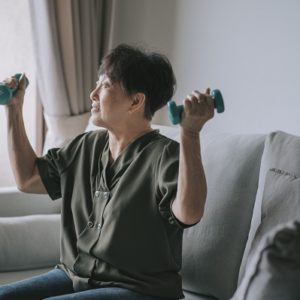May 10, 2022

May is Arthritis Awareness Month. Over 54 million people in the U.S. are living with arthritis, and with the aging of our population, that number will grow.
Arthritis is the general term for a group of more than 100 conditions that affect the joints or the tissues around the joint. Osteoarthritis is the most common type, followed by rheumatoid arthritis and gout. Arthritis results from a combination of genetic factors, lifestyle and environment. And though people of any age can have arthritis, age is a top risk factor.
Treatment for arthritis is individualized, and might include medications, physical therapy and sometimes surgery. Today, experts also tell us that exercise is one of the best ways to manage arthritis.
Some older adults might recall the days when people with arthritis were advised to take it easy and rest their joints. But we know now that “sit all day” was very bad advice! Multiple studies show that inactivity not only raises the risk of arthritis, but also leads to increased joint damage and pain for people with arthritis.
The Arthritis Foundation calls exercise “the most effective non-drug treatment for reducing pain and improving movement.” Exercise helps keep the joints lubricated and strengthens the muscles that support the joints. It helps prevent the breakdown of cartilage by reducing inflammation. It also helps seniors maintain a healthy weight—one of the most important things we can do to be kind to our joints.
How much, and what type, of exercise is best for seniors with arthritis?
While the standard guidance for exercise in older adults calls for 150 minutes per week, a study from Northwestern University showed that less is still good. “Just one hour a week of brisk walking—as if you are late to an appointment or trying to make a train—staves off disability in older adults with arthritis pain, or aching or stiffness in a knee, hip, ankle or foot,” said research team leader Prof. Dorothy Dunlop. “This is less than 10 minutes a day for people to maintain their independence. It’s very doable.”
Another study conducted by Prof. Dunlop showed that exercise need not be vigorous, or even moderate; lighter activities are also beneficial. “We were delighted to see that more time spent during the day, simply moving your body, even at a light intensity, may reduce disability,” she said. “Now people with health problems or physical limitations who cannot increase the intensity of their activity have a starting place in the effort to stay independent.”
Beginning a joint-friendly exercise program
The first step is to get a “prescription” for an exercise plan from the doctor or physical therapist. Some exercises may be unsafe for people with certain types of arthritis. Others may be safe and recommended, yet might cause discomfort, especially as a person adjusts to the regimen, so that it seems counterintuitive to continue. A trained professional can offer reassurance that creates confidence to stick with it.
An appropriate exercise plan will most likely include several types of low-impact, joint-friendly activities:
- Range-of-motion exercises relieve stiffness and improve flexibility. These exercises, which might include tai chi and stretching, can help prevent loss of the ability to move the joints.
- Strengthening exercises help the muscles support the joints. These might include working out with weights or exercise bands.
- Balance exercises reduce the risk of falls. Tai chi is a good balance activity. Some exercises like walking backwards or standing on one foot can be done at home, and there are also group classes (many available online these days).
- Aerobic activities increase endurance, can reduce swelling in some joints, and help maintain a healthy weight. Low-impact activities that do not put stress on the joints include walking, biking, dancing and water aerobics.
Source: IlluminAge with information from Northwestern University
